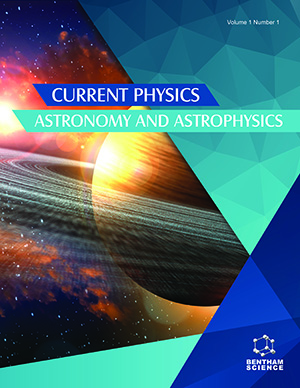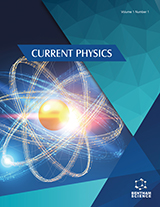About The Section

Astronomy and Astrophysics
Publishes original research articles, letters, case reports, reviews/mini-reviews and guest edited thematic issues on various topics related to Astronomy and Astrophysics.
The section Astronomyand Astrophysics of the journal Current Physics publishesoriginal research articles, letters, reviews/mini-reviews, and guest-editedthematic issues on various topics covering the entire range of astronomy,astrophysics, and cosmology. Publications in the section constitute theoriginal work directly related to the techniques, instrumentations,observations, data analysis, and theoretical research. Submissions in thefollowing area are of special interest to the readers of the journal:
· Infrared and ultraviolet astronomy
· Large-scale structures in the universe
· Optical astronomy
· Origin and dynamics of the galactic cosmic rays
· Properties of the dark matter, dark energy, and black holes
· Radio astronomy
· Stellar dynamics and evolution
· Study of gravitational waves
· X-ray and gamma-rayastronomy





DRreceived his Ph.D. degree from the Moscow Institute of Physics and Technology, and later the highest degree of Doctor of Sciences from the Institute of General Physics of the Academy of Sciences of the USSR by the decision of the Scientific Council led by the Nobel Prize winner, academician A.M. Prokhorov. According to the Statute of the Doctor of Sciences degree, this highest degree is awarded only to the most outstanding Ph.D. scientists who founded a new research field of a great interest. Oks worked in Moscow (USSR) as the head of a research unit at the Center for Studying Surfaces and Vacuum, then – at the Ruhr University in Bochum (Germany) as an invited professor, and for the last 30 years – at the Physics Department of the Auburn University (USA) as Professor. He conducted different research studies in the areas of atomic and molecular physics, astrophysics, plasma physics, laser physics, and nonlinear dynamics. He founded/co-founded and developed new research fields, such as intra-Stark spectroscopy (new class of nonlinear optical phenomena in plasmas), masing without inversion (advanced schemes for generating/amplifying coherent microwave radiation), and quantum chaos (nonlinear dynamics in the microscopic world). He also developed a large number of advanced spectroscopic methods for diagnosing various laboratory and astrophysical plasmas – the methods that were then used and are used by many experimental groups around the world.










